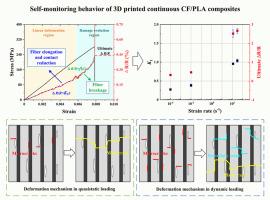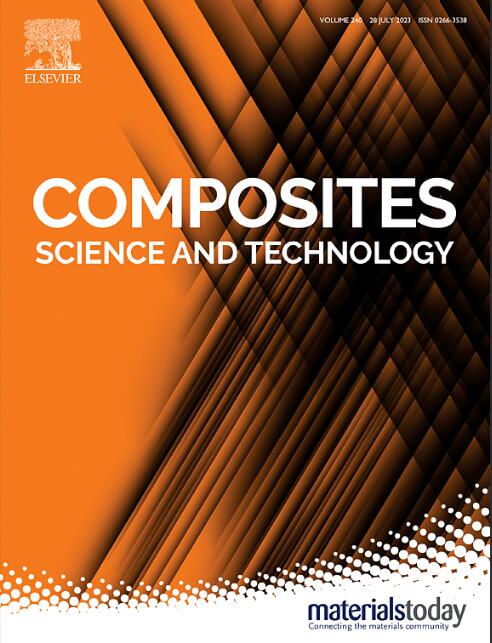Rate-dependent mechanical and self-monitoring behaviors of 3D printed continuous carbon fiber composites
IF 8.3
1区 材料科学
Q1 MATERIALS SCIENCE, COMPOSITES
引用次数: 0
Abstract
3D printed continuous carbon fiber reinforced polymer (CFRP) composites offer great advantages in structural health monitoring (SHM) owing to their flexibility in complex structure fabrication. Considering the many prospective aerospace applications, tensile experiments were designed to study their mechanical and self-sensing behaviors under a wide range of strain rates. The turning points in the resistance vs strain curves reveal the damage evolution of the specimens and divide the deformations into linear straining and damage evolution regions. Fiber elongation and fiber contact reduction dominate the resistance increase in the linear straining region and the resistance curve behaves linearly. But fiber breakage is the predominant factor in the damage evolution region, yielding a concave resistance curve. Strength, fracture strain, and resistance variation are found to display significant strain rate dependencies that increase with increasing strain rate. Numerous microcracks are formed and evolved into secondary cracks under dynamic loading. This process absorbs more strain energy and produces more carbon fiber breaks, sustaining a higher fracture strain and resistance variations. A model is developed to describe the strain- and strain rate-dependent resistance behaviors, and the predicted results agree well with experimental data. The outcomes of this work contribute to the application of 3D printed continuous CFRP composites in SHM.

三维打印连续碳纤维复合材料随速率变化的机械和自我监测行为
三维打印连续碳纤维增强聚合物(CFRP)复合材料因其在复杂结构制造中的灵活性,在结构健康监测(SHM)方面具有巨大优势。考虑到其在航空航天领域的广泛应用前景,我们设计了拉伸实验来研究其在各种应变速率下的机械和自感应行为。电阻与应变曲线的转折点揭示了试样的损伤演变,并将变形分为线性应变和损伤演变区域。在线性应变区域,纤维伸长和纤维接触减少是电阻增加的主要原因,电阻曲线也呈线性变化。但在损伤演化区域,纤维断裂是主要因素,从而产生一条凹形阻力曲线。研究发现,强度、断裂应变和阻力变化与应变速率有显著的相关性,并随着应变速率的增加而增加。在动态加载条件下,大量微裂纹形成并演变为二次裂纹。这一过程吸收了更多的应变能,产生了更多的碳纤维断裂,维持了更高的断裂应变和阻力变化。我们建立了一个模型来描述与应变和应变率相关的电阻行为,预测结果与实验数据十分吻合。这项工作的成果有助于三维打印连续 CFRP 复合材料在 SHM 中的应用。
本文章由计算机程序翻译,如有差异,请以英文原文为准。
求助全文
约1分钟内获得全文
求助全文
来源期刊

Composites Science and Technology
工程技术-材料科学:复合
CiteScore
16.20
自引率
9.90%
发文量
611
审稿时长
33 days
期刊介绍:
Composites Science and Technology publishes refereed original articles on the fundamental and applied science of engineering composites. The focus of this journal is on polymeric matrix composites with reinforcements/fillers ranging from nano- to macro-scale. CSTE encourages manuscripts reporting unique, innovative contributions to the physics, chemistry, materials science and applied mechanics aspects of advanced composites.
Besides traditional fiber reinforced composites, novel composites with significant potential for engineering applications are encouraged.
 求助内容:
求助内容: 应助结果提醒方式:
应助结果提醒方式:


